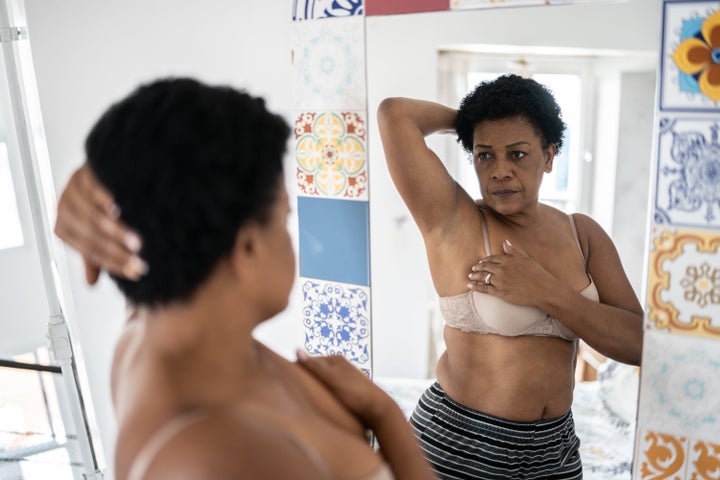The kind of breasts you have is determined by genetics. Having lumpy or smooth breasts is just like having large or small ones; it’s out of your control and often not a cause for concern.
While having breasts that are unique to you is perfectly normal, cancer checks can be harder for people with lumpy breasts. If you notice that your breast tissue feels bumpy or even rope-like, you may be one of the many people who face this difficulty.
“Women with breasts that are lumpy-bumpy are either afraid to do any checks or note any [concerning] areas in the breast because they are worried that they’re going to think everything is cancer,” said Dr. Laura Dominici, the section chief of breast surgery at Brigham and Women’s Faulkner Hospital in Massachusetts.
This deters them from checking for any issues at all because they’re worried they aren’t going to know what they’re looking for, she added.
According to Dr. Janet Yeh, the site chief of breast surgical oncology at NYU Langone Hospital—Brooklyn in New York, the breast masses that people find during at-home self-checks are typically not concerning (as long as they’re staying up to date with their in-office appointments, too). Most signs of breast cancer are caught by the advanced technology used in imaging, like mammograms and sonograms.
But self-checks don’t have any downsides, Yeh said. In fact, they’re encouraged since some people do find notable concerns during a regular, at-home check.
If you have lumpy boobs and are afraid to do a self-exam, you are certainly not alone. Here, experts share how people with lumpy breasts can conduct at-home exams and what to look for when they do.
First, be aware of how your breasts look and feel.
Gone are the days of very dictated and specific self-exams. Now, you should just have overall self-awareness to help monitor for any signs of breast cancer, according to both Dominici and Yeh.
“It’s a really good thing for women to have a general sense [of] how their breast usually looks and feels,” Dominici said.
This way, if something is new, different or concerning, you’ll be able to make note of it and bring it to your doctor’s attention, she said.
For people with lumpy breasts, knowing when a lump is normal or abnormal can be challenging. To determine how your breasts should feel, Yeh recommended that you conduct an at-home exam within a month of a breast exam by a physician or after a mammogram indicating that everything looked OK.
If you do an at-home exam when you have a clean bill of breast health, you’ll know what lumps and bumps are normal for your boobs. So, when you conduct checks in the months and years to come, you’ll be able to recognize if any lumps pop up that aren’t normally present.
Check a few key places during your self-exam.
Though knowing your boobs is more important than conducting an at-home exam in one specific way, some tips can make your self-check more effective.
First, lift up the arm closest to the breast that you’re checking, Yeh said. Feel all around the breast, including the center area.
Lastly, don’t end right at the boob; you’ll want to check your armpit, too. Armpits have lymph nodes that can become enlarged in people with breast cancer. In such cases, those lymph nodes feel firm, Yeh said. Normally, lymph nodes are soft.
To check your armpit, “put your hand on your hip on [the] side [you’re checking],” Yeh said. “You can use your other hand to fill in your armpit.”
Sakan Piriyapongsak / EyeEm via Getty Images
Also check for similar lumps in both boobs.
If you find a mass in one breast, check the other one to see whether you feel a similar lump there, Yeh said.
If you feel something of a similar size and texture in the other breast, that may just be how your tissue normally feels.
Perform your self-exams right after your period.
Many people report that their breasts feel especially tender right before and during their period, Dominici said. So, doing your breast exam may be painful at these times.
Additionally, many folks deal with swollen boobs before and during their period, which could make their breasts feel different than usual, Dominici added. This could lead to some false alarms during your check.
So, it’s best to wait for your period to end before you do a self-exam.
Dominici recommended performing self-exams at the same time every month, and having a set routine for the check may be helpful. You could consistently do your exam in the shower, in bed or in front of a mirror. That way, you’ll eventually get into a groove and know exactly how your boobs should feel in a particular position.
A concerning lump should stand out from the rest of your tissue.
“Lots of women have lumps in their breasts. What I recommend is feeling for anything that stands out,” Yeh said.
When breast cancer is palpable, it’s firm, Yeh said. She noted that a concerning lump should almost feel like a pea in mashed potatoes.
Yeh added that beyond a lump, you should let your doctor know about any redness, swelling or dimpling of the skin. Discharge from your nipple when you aren’t touching or squeezing it is another red flag.

FG Trade via Getty Images
Self-exams can only show so much. Be sure to stay on top of your breast imaging, too.
“Your breast imaging should start at 40 and [take place] every year,” Yeh said.
In some situations, that imaging is necessary at a younger age. This can be the case for people with certain gene mutations or with a significant family history.
“We recommend people start breast imaging 10 years before the closest relative was diagnosed, or at the age of 40 — whatever comes first,” Yeh said. So, if your mom was diagnosed with breast cancer at 44, you should consider starting your routine mammograms at 34.
If you do feel a concerning lump, talk to your doctor.
If you think what you’re feeling may be abnormal but are not sure, don’t be afraid to reach out to your doctor. It’s absolutely better to be safe than sorry in this situation. Plus, experts agree that it’s hard for women to know the difference between something that’s OK and not OK.
“It can be challenging for women who [have] lumpy-bumpy [breasts] because a lot of times a cyst or a fibroadenoma, which are benign findings, can feel like a firm lump,” Dominici said.
In the end, if you have any doubt, you shouldn’t assume that what you’re feeling is normal. Your doctor is there to help you and will likely be happy that you brought a potential abnormality to their attention.


